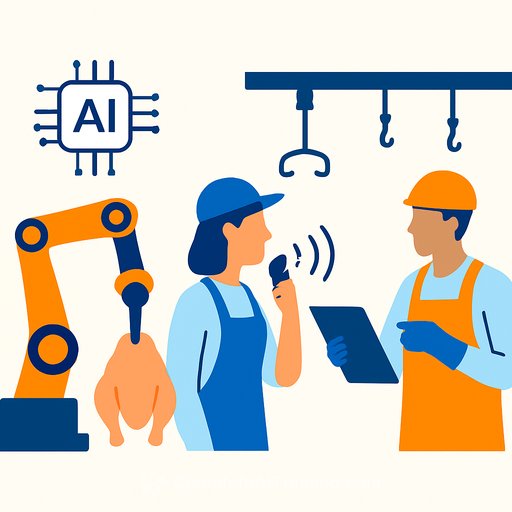AI tools can sharpen poultry processing management
Predictive scheduling, voice-activated assistants, and machine intelligence in the plant are moving from pilot to practical. For managers, the payoff is clearer traceability, tighter food safety, and faster onboarding that sticks.
"The food industry has been pushing its digital transformation as long as it could and I think now is the time," said Paulo Gaspar, CEO of BRAINR. "Customers are demanding more, supermarkets are demanding more, and the quality controls are increasing... especially with everything related to animal welfare."
Where AI delivers value on the floor
- Demand forecasting and production scheduling: Models predict orders by SKU, channel, and day. Outcome: fewer changeovers, steadier throughput, and lower giveaway.
- Intelligent user interfaces: Conversational agents answer questions about production orders, products, and procedures so teams don't have to click through layers of menus.
- Automated quality checks: "Virtual employees" verify registries, confirm order completion, flag gaps, and generate alerts. Hours of paperwork shrink to minutes.
- Voice-enabled personal assistants: Headset prompts guide tasks by role and line, unlocking real-time help for new hires and keeping experienced staff aligned to standard work.
As Gaspar noted, first-day workers don't need to learn every screen. They can ask for the order, the spec, or the step-and get the right answer without stopping the line.
Why the timing makes sense for management
- Retail and export pressure: More audits, tighter specs, and proof of animal welfare.
- Labor churn: Faster competency reduces rework and callbacks, and keeps new hires engaged.
- Compliance and traceability: Digital records close gaps across receiving, evisceration, debone, and pack-out.
Implementation playbook: incremental beats "big bang"
Skip the single go-live. Implement in small, high-impact slices and expand.
- Pick one area: Example: QC registry verification in evisceration or voice support for debone changeovers.
- Deploy and stabilize: Run side-by-side with current SOPs for 2-4 weeks. Measure defects, downtime, and rework.
- Train on the job: Teach during real shifts, not classrooms. Rotate leads so knowledge spreads.
- Roll to the next area: Extend to scheduling, then materials, then finished goods traceability.
As Gaspar advises, "Start with one part of the factory, put it live, then move to the next-train people in their day-to-day instead of waiting for one magical day for everything to change."
Compliance and traceability anchors
AI should reinforce, not replace, your programs. Tie every model and assistant to existing HACCP, SSOPs, and audit trails.
- Map digital records to critical control points, lot codes, and retention schedules.
- Push exceptions to supervisors with time-stamped evidence.
- Use standard identifiers (GTIN, lot, batch) to link live ops with ERP and WMS.
Helpful references: USDA FSIS HACCP resources and GS1 traceability standards.
Quick ROI snapshot
- Scheduling accuracy: 2-5% throughput lift from fewer changeovers and overtime cuts.
- Giveaway reduction: 0.2-0.5% yield gain from tighter spec control across debone and pack.
- Onboarding time: 30-50% faster time-to-competency with voice guidance and in-line coaching.
- Quality admin hours: 50-80% fewer manual checks via automated registry validation.
Even at conservative assumptions, a single complex can often justify a pilot in one quarter.
Pilot blueprint (30/60/90)
- Days 1-30: Define the use case, success metrics, and data feeds. Clean master data (SKUs, specs, shifts). Fit-test headsets and user access.
- Days 31-60: Go live in one area on one shift. Daily standups. Fix edge cases. Compare against baseline KPIs.
- Days 61-90: Extend to a second shift or parallel line. Lock SOP changes. Present ROI and scale plan to leadership.
Risk controls that keep you audit-ready
- Data quality: No model beats bad specs. Assign ownership for each field and run weekly audits.
- Worker acceptance: Make the assistant useful on day one-answers, not lectures. Recognize line leads who adopt early.
- Security: Use role-based access and log every action. Keep PII out of prompts. Review vendor SOC 2 and incident playbooks.
- Model oversight: Document versions, prompts, and thresholds. Escalate exceptions to humans-always.
Manager checklist
- Top 3 KPIs to move in 90 days: yield, schedule adherence, training time.
- One area to start where data is clean and ownership is clear.
- Clear "stop" criteria: if alerts exceed X/day or model accuracy dips below Y%, revert and fix.
- Weekly review with Ops, QA, HR, and IT to keep decisions fast.
Build team capability
If you need a quick upskill path for supervisors and leads working with AI-enabled workflows, see these management-focused resources from Complete AI Training: Courses by job and AI Automation Certification.
Bottom line: start small, measure hard, expand where the numbers prove it. The plants that do this well will run steadier, waste less, and keep people longer.
Your membership also unlocks:






